MOJ
eISSN: 2573-2919


Research Article Volume 5 Issue 4
1Central Ethiopia Environment and Forest Research Center, EEFRI, Ethiopia
2Ethiopian Environment and Forest Research Institute (EEFRI), Ethiopia
3Jimma Environment and Forest Research Center, EEFRI, Ethiopia
Correspondence: Mohammed Adefa Seid, Central Ethiopia Environment and Forest Research Center, EEFRI, P.O.Box 33042, Gurd Shola Road, Addis Ababa, Ethiopia, Tel +251-912687040
Received: June 18, 2020 | Published: July 20, 2020
Citation: Seid MA, Mulatu Y, Anjulo A, et al. Population survey of Milicia excelsa, Pouteria adolfi-fridercii, Antiaris toxicaria and Prunus africana in south and south-western Ethiopia: implications for domesticating and establishing Seed Production Areas. MOJ Eco Environ Sci. 2020;5(4):153-162. DOI: 10.15406/mojes.2020.05.00188
The population dynamics and genetic qualities of stem height and dbh of the populations of Milicia excelsa, Pouteria adolfi-fridercii, Antiaris toxicaria and Prunus africana were assessed and studied in 14 forest ecosystems in south and south-western Ethiopia. A systematic random quadrat sampling technique was employed to identify potential habitat area for selected timber species in south and south-western Ethiopia. So, a total of 10 parallel transect lines were set out across each forest habitat. Milicia excelsa was assessed in four forest ecosystems; Bebeka -Duduka natural forest (45 tree stem ha-1) and Yayu coffee mixed forest (40 tree stem ha-1) appeared to have relatively denser population of M. excelsa compared to the other pilot forests. Similarly, statistically larger stem height (m) is observed in Bebeka-Duduka natural forest (x̅=29.5, SD=4.2) and larger dbh size (cm) in Bebeka 1 coffee mixed forest (x̅=48.5, SD=25.2) at p<0.05. Hence, Bebeka-Duduka natural forest and Bebeka 1 coffee mixed forests are identified for in-situ SPA establishment project of the target species. Pouteria adolfi-fridercii was assessed in eight forest ecosystems; Masha-Gora shewi forest appeared to have dense population of P. adolfi-fridercii (150 tree stem ha-1) followed by Bebeka-Kebereta (80 tree stem ha-1) as compared to the remaining pilot forests. However, statistically larger stem height (m) is scored in Bebeka 2 natural forest (x̅=30.6, SD=2.98) and Bebeka-kebereta forest (x̅=30.0, SD=4.4) and larger dbh size (cm) in Bebeka 2 natural forest (x̅=96.5, SD=19.9) at p<0.05. So, Bebeka 2 natural forest and Bebeka-kebereta forest are identified for SPA establishment project of the target species. Antiaris toxicaria was assessed in two forest ecosystems where both forest habitats appeared to have the same density of Antiaris toxicaria in hectare. Moreover, analyses of mean stem height (cm) of Bebeka 1 forest (x̅=21.4, SD=5.2) and Bebeka-kebereta forest (x̅=22.4, SD=2.7), and mean dbh size (cm) of Bebeka 1 forest (x̅=48, SD=16.4) and Bebeka-kebereta forest (x̅=48, SD=8.2) appeared to have not significantly different at p<0.05. Prunus africana was assessed in five forest ecosystems; Masha-Gora shewi forest appeared to have dense population of Prunus africana (150 tree stem ha-1) followed by Kaho-shemeta forest (130 tree stem ha-1) as compared to the remaining pilot forests. However, statistically larger stem height (m) is scored in Kaho-shemeta natural forest (x̅=31, SD=7.6) and larger dbh (cm) in Masha-Gora shewi forest (x̅=64.7, SD=28.2) at p<0.05. As the result, Kaho-shemeta natural forest and Bonga-Teja-adela forest are identified for establishment of seed production area of the target species in-situ. Hence, while implementing the project of domestication and seed production area establishment in south and south-western Ethiopia, in-situ and ex-situ areas must be selected and delineated in accordance with this preliminary information of the population dynamics and genetic qualities of stem height and diameter at breast height. The survey data generated in this study would bridge the research gap in relation to the population status of the target tree species in the designated area.
Keywords: indigenous tree species, population, functional traits, density, height, diameter
Ethiopia is becoming dependent on wood products imported, and the demand for sawn wood, paper and ply wood is steadily increasing each year.1 In spite of there are many indigenous timber species in Ethiopia, species used for domestic timber production are limited to 3 to 4 species namely Eucalyptus, Cupresuss, Pinus and to some extent Grevillea. However, potential timber species including Milicia excelsa, Antiaris toxicaria, Pouteria adolfi-fridercii and Prunus africana, restricted within natural forest ecosystems in south and south-western parts of the country, can be used for production of quality timber.2
Natural forests in western and south-western Ethiopia are the major sources of livelihood (timber and non-timber forest products) for the communities in the surrounding area.3 These forests are also the potential sources of economically important timber species such as Milicia excelsa, Antiaris toxicaria, Pouteria adolfi-fridercii and Prunus africana. However, in recent years, conversion of forest ecosystems into agriculture lands (coffee and tea plantations) is becoming increasing. As the result, species such as Milicia excelsa, Antiaris toxicaria, Pouteria adolfi-fridercii and Prunus africana are under high pressure due to random cuttings and deforestation.4,5 To the knowledge of the researcher, the population status of these tree species in the designated area is not well documented. So, it is becoming necessary to find innovative ways of maintaining and improving the genetic quality of these species by domesticating them into a wider scale of ecological and social environment and upgrading the seed supply by developing Seed Production Areas (SPA). The survey data generated in this study would help to bridge the research gap in relation to the population status of the target tree species in the designated area. Therefore, the main objective of this study was to assess the population dynamics (density), stem height and dbh size of Milicia excelsa, Pouteria adolfi-fridercii, Antiaris toxicaria and Prunus africana in south and south-western Ethiopia. The study was specifically designed (1) to conduct a population survey of Milicia excelsa, Pouteria adolfi-fridercii, Antiaris toxicaria and Prunus africana in selected forest ecosystems in south and south-western Ethiopia, (2) to measure the regeneration status of each species in their habitats, and (3) to measure the stem height and diameter at breast height (dbh) size of the population of the target species thereby domesticating the best populations and establishing Seed Production Area (SPA) for the target species in-situ and ex-situ.
Measuring population dynamics and natural regeneration
A Systematic random quadrat sampling technique was employed, i.e. representative forest habitat areas were identified and systematically selected for sampling purpose. A total of 10 parallel transect lines (160m) were measured out across a representative forest habitat area, and 30 quadrats (20m by 20m) were laid randomly at 50m interval along each transect line.6–8 Hence, matured tree population, with DBH ≥2.5cm and Height ≥1.5m was counted, analyzed and summarized in tables.9 On the other hand, seedling and sapling counts (seedlings are young of tree species with DBH <2.5cm and height 1-50cm and saplings are young of tree species with DBH <2.5cm and height between 50-150cm was conducted in each 20m by 20m quadrat.9 So, at every 50m along the line, 5m by 5m sub-plots were placed to count the seedling and sapling populations.10–12 Count data of the seedling and sapling population with the corresponding abundance of trees in each forest plot was recorded and summarized in tables. Hence, the regeneration status of target species in each forest habitat was analyzed by comparing the population density of seedling with sapling, and sapling with matured trees as follows8,13: 1) “good” regeneration, if density of seedling>sapling>mature tree; 2) “fair” regeneration, if density of seedling>sapling<mature tree; 3) “poor” regeneration, if a species survives only in the sapling stage, but not as seedlings (even though saplings may be less than, more than, or equal to mature trees); 4) “none”, if a species is absent both in sapling and seedling stages, but present as mature; and 5) “new”, if a species has no mature, but only sapling and/or seedling stages.
Measuring functional traits (stem height and dbh)
A Systematic random quadrat sampling technique was employed, i.e. representative forest habitat areas were identified and systematically selected for sampling purpose. A total of 10 parallel transect lines (160m) were measured out across a representative forest habitat area, and 30 quadrats (20m by 20m) were laid randomly at 50m interval along each transect line (modified from.6–8 Hence, for trees with DBH ≥2.5cm and Height ≥1.5m, stem height and dbh (at 1.3m above the ground) were recorded,9 and the data was analyzed, tested and presented in figures and tables. T-tests were computed for the purpose of mean comparison and determining the level of mean separations (significance level at p<0.05%) amongst the different forest habitats.
Result and discussion
The population dynamics and regeneration status of Milicia excelsa, Pouteria adolfi-fridercii, Antiaris toxicaria and Prunus africana were assessed and studied in 13 forest ecosystems (3 sites in Metu zone, 3 sites in Sheka zone, 3 sites in Kaffa zone, and 4 sites in Benchi-Maji zone (Table 1). The survey data generated in this study would bridge the research gap in relation to the population status of the target tree species in the designated area.
Forest name (site) |
GPS location |
Substrate (soil) type |
Humidity / rainfall |
Associated biotic community |
Yayu forest biosphere |
08o22’35.7” N |
Loam to clay soil; poor drained reddish to blackish soil, 15-20 cm thick liter and humus |
High humidity/ rainfall |
Plants: Coffee, Albizia sp., other shrubs and herbs; Animals: Wild mammals , and insects etc. |
036o01’37.8” E |
||||
Bebeka 1- coffee mixed forest |
06o54’13.6” N |
Sandy loam and moderately drained reddish soil; 15-20 cm thick liter and humus |
Intermediate humidity/ rainfall |
Plants: Coffee, other trees, shrubs and herbs; Animals: Wild mammals, , and insects etc. |
035o26’36.6” E |
||||
Bebeka 2- natural forest |
06o51’28.1” N |
Sandy loam and moderately drained reddish soil; 15-20 cm thick liter and humus |
Medium humidity/ rainfall |
Plants: M. excelsa and other higher plants and climbers; Animals: Hyena, primates, and insects etc.. |
035o24’03.0” E |
||||
Shera-Kaffa natural forest |
07o16’39.9” N |
Sandy loam and moderately drained reddish soil; 15-20 cm thick liter and humus |
High humidity/ rainfall |
Plants: Coffee, Syzygium guineese, P. africana and other higher plants and climbers; Animals: Primates and other mammals, and insects etc. |
036o10’57.7” E |
||||
Kaho Shemeta natural forest |
07o40’19.9” N |
Sandy loam and moderately drained reddish soil; >20 cm thick liter and humus |
High humidity/ rainfall |
Plants: Pouteria sp. (low density and rare) and other higher plants and climbers; Animals: Gureza, other primates , and insects etc. |
035o29’34.8” E |
||||
Bebeka -Duduka natural forest |
06 o 55’82.5’’ N 035o28’10.3’’ E |
Sandy loam and well drained reddish soil; 15-20 cm thick liter and humus |
High humidity |
Plants: Plants: Pouteria sp., Antiaris sp., etc.; Animals: Wild mammals – pigs, primates, and insects etc. |
Yayu - Chach natural forest |
08o 22’ 22.2” N |
Loam soil; well drained reddish to blackish soil, 15-20 cm thick liter and humus. |
High humidity |
Plants: Plants: Albizia sp., Croton macrostachyus; Animals: wild mammals – pigs, primates , and insects etc. |
036o 02’93.”6 E |
||||
Bebeka -Kebereta forest |
06 o 55’82.5” N |
Loam and moderate well drained reddish soil; 10-15 cm thick liter and humus |
High humidity |
Plants: Plants: M. excelsa, Antiaris sp.; Animals: wild mammals – pigs, primates , and insects etc. |
035o 52’81.0” E |
||||
Bonga -Shera forest |
07o16’73.1” N |
Moderately well drained soil; 15-25 cm thick liter and humus |
High humidity |
Plants: Plants: P. africana, C. macrostachyus Animals: Wild mammals – pigs, primates , and insects etc. |
036 o10’51.8” E |
||||
Masha-Gora shewi forest |
07o37’60.3” N |
Sandy loam and moderately drained soil; 15-25 cm thick liter and humus |
High humidity |
Plants: Plants: P. africana, Ficus sp., Syzygium sp., Animals: Wild mammals: pigs, primates , and insects etc. |
035o 30’06.0” E |
||||
Masha - Sherach forest |
07o37’45.0” N |
Sandy loam and moderately drained soil; 15-25 cm thick liter and humus |
High humidity |
Plants: Plants: P. africana, Ficus sp., Syzygium sp.; Animals: Wild mammals – pigs, primates, and insects etc. |
035o52’99.9” E |
||||
Yayu -Wabu Dureni forest |
08 o22’86.5 “N |
Clay to Loam soil; moderate drained reddish to blackish soil, 15-25 cm thick liter and humus |
High humidity |
Plants: Plants: M .excelsa, C. macrostachyus; Animals: wild mammals – pigs, primates , and Insects etc. |
035o 48’05.5” E |
||||
Bonga-Teja-adela forest |
07o16’41.7” N |
Moderately well drained soil; 10-15 cm thick liter and humus |
High humidity |
Plants: Ekebergia spp., Olea sp. , C. macrostaycus; Animals: wild mammals – pigs, primates, and insects etc. |
036o 12’75.”1 E |
|
Table 1 Summary of the study pilot forest sites; physical and biological components of the ecosystems
Milicia excelsa
Population dynamics and regeneration status
Milicia excelsa (Rock-elm, Iroko) was studied and documented in four forest ecosystem; Yayu coffee mixed forest, Bebeka 1 coffee mixed forest, Bebeka-Duduka natural forest and Yayu-Chach natural forest (Table 2). So, the forest systems are attributed by both natural and mixed forest type. Bebeka -Duduka natural forest (45 tree stem ha-1) and Yayu coffee mixed forest (40 tree stem ha-1) appeared to have relatively denser population of M. excelsa compared to the other pilot forests.
Forest site |
Total counts (N) |
Density (per ha) |
Distribution/ Dispersion |
Reg. status mcep164 |
Overstory shading |
||
Seedling |
Sapling |
Trees |
(x̅*10000/ 400 m2) |
(S2/x̅ ratio) |
|||
Yayu |
0 |
0 |
16 |
40 |
1 = Random distribution and intermediate dispersion |
None |
Partial |
Bebeka 1 |
34 |
0 |
8 |
20 |
0.78 = Uniform distribution and high dispersion |
Fair |
Partial |
Bebeka -Duduka |
19 |
10 |
18 |
45 |
1.53= aggregately distributed, low dispersion |
Fair |
Partial |
Yayu - Chach natural |
0 |
0 |
6 |
15 |
2.7= aggregately distributed, low dispersion |
None |
Partial |
Table 2 Summary descriptions of Yayu and Bebeka 1, Bebeka -Duduka natural forest and Yayu - Chach natural forest pilot survey sites in reference to M.excelsa
The existence of “none regeneration” status in Yayu coffee mixed forest could be due to the presence of frequent clearing-up works in coffee mixed forest that could have possibly hindered the germination of dispersed seeds on the ground. On the other hand, the existence of “none regeneration” status in Yayu-Chach natural forest could be related to presence of unsuitable environmental conditions or may it was not the right phenological calendar for the trees to set and disperses their seeds during our survey period.
Analysis of stem height and dbh
Analysis of t-test for mean stem height of M. excelsa population in Yayu coffee mixed forest (x̅=23.31, SD=7.6, SE=4.01), Bebeka 1 coffee mixed forest (x̅=21.4, SD=3, SE=0.75), Bebeka-Duduka natural forest (x̅=29.5, SD=4.2, SE=1.0) and Yayu-Chach natural forest (x̅=21.5, SD=12, SE=4.9) shows that M. excelsa population in Bebeka-Duduka natural forest has significantly larger mean stem size at p<0.05 compared to the remaining pilot forest sites (Figure 1). However, no significant difference of mean stem height is observed amongst the other three sampling sites at p<0.05. On the other hand, it also reported that old trees of M. excelsa could reach 21-50meters high, and grows in Moist and Wet Kolla agro-climatic zones of Ilubabor and Kaffa regions in the altitude of 500-1000meter above sea level.14,15 According to Agroforestry Database, M. excelsa is a deciduous tree having 30-50meter stem height.16
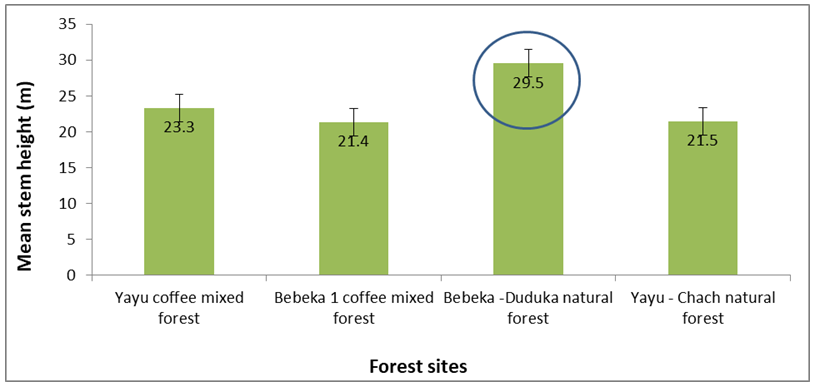
Figure 1 Comparison of mean (x̅)and standard error (SE) for measurements of stem heights of M. excelsa population in Yayu coffee mixed forest, Bebeka 1 coffee mixed forest, Bebeka-Duduka natural forest and Yayu-Chach natural forest. Stem height ranging from 10-36m is recorded in Yayu coffee mixed forest, 17-26m in Bebeka 1 coffee mixed forest, 22-32m in Bebeka-Duduka natural forest and 10-35m in Yayu-Chach natural forest.
Analysis of t-test for mean dbh of M. excelsa population in Yayu coffee mixed forest (x̅=34.7, SD=27.2, SE=6.8), Bebeka 1 coffee mixed forest (x̅=48.5, SD=25.2, SE=8.9), Bebeka-Duduka natural forest (x̅=36.5, SD=8.2, SE=1.9) and Yayu-Chach natural forest (x̅=37.52, SD=26.3, SE=10.7) shows that M. excelsa population in Bebeka 1 coffee mixed forest has significantly larger mean dbh at p<0.05 compared to the remaining pilot forest sites (Figure 2). However, no significant difference of mean DBH is observed amongst the other three sampling sites. Similarly14,15 reported that old trees of M. excelsa may reach 2meters in diameter. According to Agroforestry Database, M. excelsa is a large deciduous tree reported to have diameter of 2-10meters dbh length.16 The larger record of DBH size in Bebeka 1 coffee mixed forest might be due to the fact that the coffee estate routinely manage the forest as part of clearing-up management works so that it in turn decrease the competition for nutrients. M. excelsa in this forest habitat is managed to attain the larger DBH size possible compared to the remaining untouched and partially disturbed forests piloted. Stem dbh is also related with the age of the tree; the older the tree the wider the diameter it possess if other environmental conditions are constant and favorable. The overall vegetation density of an ecosystem and the level of nutrients competitions would also affect carbon accumulation of a tree and its size of the diameter as well.
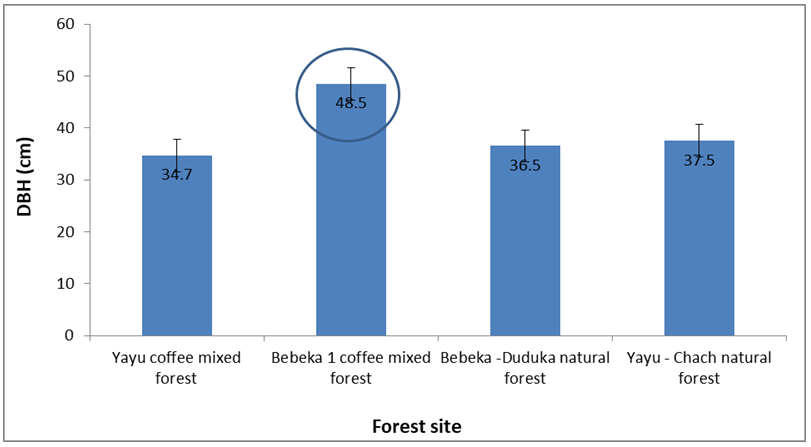
Figure 2 Comparison of mean (x̅)and standard error (SE) for measurements of dbh of M. excelsa population in Yayu coffee mixed forest, Bebeka 1 coffee mixed forest, Bebeka-Duduka natural forest and Yayu-Chach natural forest; dbh size of 10-100cm is recorded in Yayu coffee mixed forest, 20-100cm in Bebeka 1 coffee mixed forest, 24-46.5cm in Bebeka-Duduka natural forest and 13-70cm in Yayu-Chach natural forest.
Pouteria adolfi-fridercii
Population dynamics and regeneration status
Pouteria adolfi-fridercii was surveyed in eight forest ecosystems namely Bebeka 2 natural forest, Yayu coffee mixed forest, Shera-Kaffa natural forest (undisturbed), Bebeka-kebereta forest, Bonga-Shera forest, Masha-Gora shewi forest, Masha-Sherach forest and Yayu-Wabu Dureni forest (Table 3). Masha-Gora shewi forest appeared to have dense population of P. adolfi-fridercii (150 tree stem ha-1) followed by Bebeka-Kebereta (80 tree stem ha-1) as compared to the remaining pilot forests.
Forest site |
Total counts (N) |
Density (per ha) |
Distribution/ Dispersion |
Reg. status |
Overstory shading |
||
Seedling |
Sapling |
Trees |
(x̅*10000/ 400m2) |
(S2/x̅ ratio) |
|||
Yayu |
12 |
0 |
13 |
32.5 |
4.8=aggregately distributed and low dispersion |
Fair |
Partial |
Bebeka 2 |
13 |
8 |
29 |
72.5 |
3.02=aggregately distributed, low dispersion |
Fair |
Partial |
Shera-Kaffa |
20 |
7 |
30 |
75 |
0.3=uniform distribution and high dispersion |
Fair |
Partial |
Bebeka -Kebereta forest |
86 |
16 |
32 |
80 |
1.44= aggregately distributed, low dispersion |
Fair |
Partial |
Bonga -Shera forest |
14 |
19 |
22 |
55 |
4.64=aggregately distributed, low dispersion |
Poor |
Partial |
Masha-Gora shewi forest |
18 |
26 |
60 |
150 |
8= aggregately distributed, low dispersion |
Poor |
Partial |
Masha - Sherach forest |
3 |
8 |
26 |
65 |
3.3=aggregately distributed, low dispersion |
Poor |
Partial |
Yayu -Wabu Dureni forest |
6 |
12 |
21 |
52.5 |
1.6= aggregately distributed, low dispersion |
Poor |
Partial |
Table 3 Summary descriptions of Bebeka 2 natural forest, Yayu coffee mixed forest, Shera-Kaffa natural forest (undisturbed), Bebeka-kebereta forest, Bonga-Shera forest, Masha-Gora shewi forest, Masha-Sherach forest and Yayu-Wabu Dureni forest pilot survey sites in reference to Pouteria adolfi-fridercii
Analysis of stem height and dbh
Analysis t-test for mean stem height of the populations of Pouteria adolfi-fridercii in Bebeka 2 natural forest (x̅=30.6, SD=2.98, SE=0.55), Yayu coffee mixed forest (x̅=23.7, SD=6.2, SE=1.7), Shera-Kaffa natural forest (x̅=25.0, SD=10.7, SE=1.9), Bebeka-kebereta forest (x̅=30.0, SD=4.4, SE=0.78), Bonga-Shera forest (x̅=25.4, SD=5.0, SE=1.1), Masha-Gora shewi forest (x̅=26.1, SD=4.3, SE=0.55), Masha-Sherach forest (x̅=24.3, SD=5.11, SE=1.2) and Yayu-Wabu Dureni forest (x̅=24.8, SD=4.1, SE=0.88) shows that Bebeka 2 natural forest and Bebeka-kebereta forest appeared to have significantly larger mean stem height at p<0.05 compared to the other pilot forest sites (Figure 3). However, there is no evidence showing that the mean variations of stem height amongst the other pilot forest sites are significant at p<0.05. According to Agroforestry Database, Pouteria adolfi-fridercii is reported to have up to 50meter stem height.16 In this study, the maximum stem height (40m) is observed in Bebeka-kebereta forest and Shera-Kaffa natural forest while the minimum stem height (14m) is recorded in Yayu-Wabu Dureni forest. The height is also affected by the age of the tree. Moreover, the overall vegetation density of an ecosystem and the level of nutrients competitions would also affect carbon accumulation of a tree and its size.
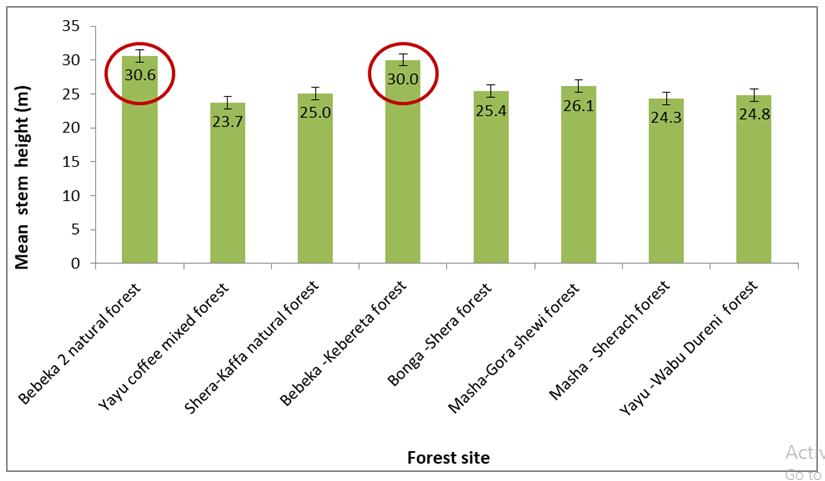
Figure 3 Comparison of mean (x̅)and standard error (SE) for measurements of stem height of Pouteria adolfi-fridercii populations in Bebeka 2 natural forest (undisturbed), Yayu coffee mixed forest (disturbed), Shera-Kaffa natural forest (undisturbed), Bebeka-kebereta forest, Bonga-Shera forest, Masha-Gora shewi forest, Masha-Sherach forest and Yayu-Wabu Dureni forest.
Analysis t-test for mean dbh of the populations of Pouteria adolfi-fridercii in Bebeka 2 natural forest (x̅=96.5, SD=19.9, SE=3.7), Yayu coffee mixed forest (x̅=36.2, SD=30.1, SE=8.3), Shera-Kaffa natural forest (x̅=42.8, SD=26.5, SE=4.8), Bebeka-kebereta forest (x̅=44.6, SD=13.0, SE=2.3), Bonga-Shera forest (x̅=35.2, SD=12.7, SE=2.7), Masha-Gora shewi forest (x̅=64.8, SD=28.2, SE=3.6), Masha-Sherach forest (x̅=40.3, SD=13.0, SE=2.7 and Yayu-Wabu Dureni forest (x̅=38.1, SD=8.1, SE=1.7) shows that Bebeka 2 natural forest appeared to have significantly larger mean dbh at p<0.05 compared to the other pilot forest sites (Figure 4). Masha-Gora shewi forest is found to be second most important site with respect to dbh size. However, there is no evidence showing that the mean variations of stem height amongst the other pilot forest sites are significant. According to Agroforestry Database, Pouteria adolfi-fridercii is reported to have up to 3 meter dbh size.16 In this study, the maximum dbh (1.5m) is observed in Bebeka 2 natural forest while the minimum dbh (8cm) is recorded in Yayu coffee mixed forest and Shera-Kaffa natural forest. Stem dbh is also affected by the age of the tree; the older the tree the wider the diameter it will possibly have if other environmental conditions are constant and favorable. Moreover, the overall vegetation density of an ecosystem and the level of nutrients competitions would also affect carbon accumulation of a tree and the size of its diameter as well.
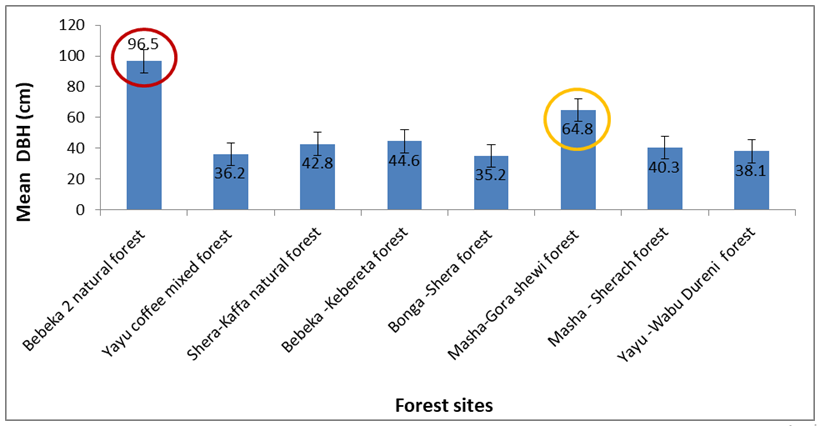
Figure 4 Comparison of mean (x̅)and standard error (SE) for measurements of dbh of Pouteria adolfi-fridercii populations in Bebeka 2 natural forest (undisturbed), Yayu coffee mixed forest (disturbed), Shera-Kaffa natural forest (undisturbed), Bebeka-kebereta forest, Bonga-Shera forest, Masha-Gora shewi forest, Masha-Sherach forest and Yayu-Wabu Dureni forest.
Prunus africana
Population dynamics and regeneration status
The population of Prunus africana was assessed in Kaho-shemeta, Bonga-Teja-adela forest, Bonga -Shera forest, Masha-Gora shewi forest and Masha - Sherach forest (Table 4). Masha-Gora shewi forest appeared to have dense population of Prunus africana (150 tree stem ha-1) followed by Kaho-shemeta forest (130 tree stem ha-1) as compared to the remaining pilot forests.
Forest site |
Total counts (N) |
Density (per ha) |
Distribution/ Dispersion |
Reg. status |
Overstory shading |
||
Seedling |
Sapling |
Trees |
(x̅*10000/ 400m2) |
(S2/x̅ ratio) |
|||
Kaho-shemeta |
130 |
29 |
52 |
130 |
5.3=aggregately distributed |
Fair |
Partial |
Bonga-Teja-adela forest |
75 |
28 |
14 |
35 |
1.4=aggregately distributed |
Good |
Partial |
Bonga -Shera forest |
12 |
3 |
11 |
27.5 |
2.1=aggregately distributed |
Fair |
Partial |
Masha-Gora shewi forest |
18 |
26 |
60 |
150 |
8=aggregately distributed |
Poor |
Partial |
Masha - Sherach forest |
76 |
28 |
47 |
117.5 |
2.8=aggregately distributed |
Fair |
Partial |
Table 4 Summary descriptions of Kaho-shemeta, Bonga-Teja-adela forest, Bonga -Shera forest, Masha-Gora shewi forest and Masha - Sherach forest
Analysis of stem height and dbh
Analysis of t-test for mean stem height of the populations of Prunus africana in Kaho-shemeta natural forest (x̅=31, SD=7.6, SE=1.0), Bonga-Teja-adela forest (x̅=25.6, SD=7.3, SE=1.9), Bonga-Shera forest (x̅=24, SD=5.2, SE=1.5), Masha-Gora shewi forest (x̅=26, SD=4.3, SE=0.5), and Masha - Sherach forest (x̅=25, SD=3.9, SE=0.5) shows that Kaho-shemeta natural forest is proven to have population with significantly larger stem height at p<0.05 compared to the remaining pilot forests (Figure 5). However, there is no evidence showing that the mean variations of stem height amongst other pilot forest sites are significant. Moreover, the SE bars of the sample means (x̅) stem height of Prunus africana population are apparently overlapped suggesting that variation of mean stem height amongst the population Prunus africana Bonga-Teja-adela forest, Bonga -Shera forest, Masha-Gora shewi forest and Masha - Sherach forest are not significant. According to Agroforestry Database, Prunus africana is reported to have 10-24 (36 max.) meters stem height.16 On the other hand,14,15 also reported that mature trees of can reach up to 40meters, and grows at 1500-2300meters above sea level with high-rainfall areas in Moist and Wet Weyna Dega agroclimatic zones and occurs in montane and riverine forests of Ilubabor, Kefa, Arsi, Wolega, Sidamo, Gonder, Gojam and Shewa regions.
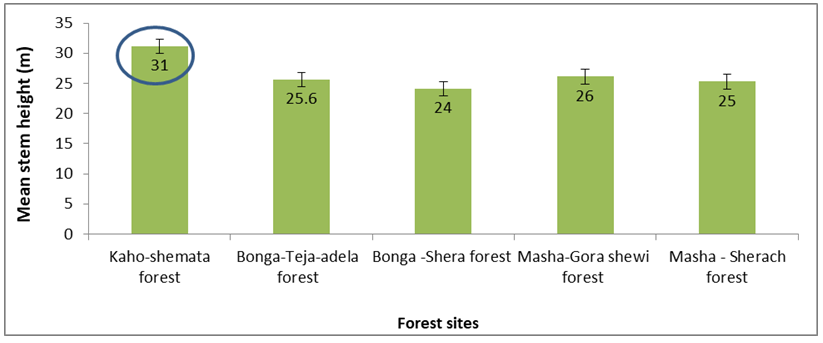
Figure 5 Comparison of mean (x̅)and standard error (SE) for measurements of stem height of Prunus africana population in Kaho-shemeta natural forest, Bonga-Teja-adela forest, Bonga -Shera forest, Masha-Gora shewi forest and Masha - Sherach forest.
Analysis of t-test for mean dbh of populations of Prunus africana in Kaho-shemeta natural forest (x̅=50, SD=30, SE=4.1), Bonga-Teja-adela forest (x̅=50, SD=17.5, SE=4.5), Bonga-Shera forest (x̅=38, SD=12.9, SE=3.9), Masha-Gora shewi forest (x̅=64.7, SD=28.2, SE=3.6), and Masha - Sherach forest (x̅=52, SD=21.4, SE=3.2) shows that Masha-Gora shewi forest (x̅=64.7, SD=28.2, SE=3.6) is found to have significantly larger mean dbh at p<0.05 compared to the remaining pilot forest sites (Figure 6). However, according to Agroforestry Database, Prunus africana have stem diameter of 1meter.16
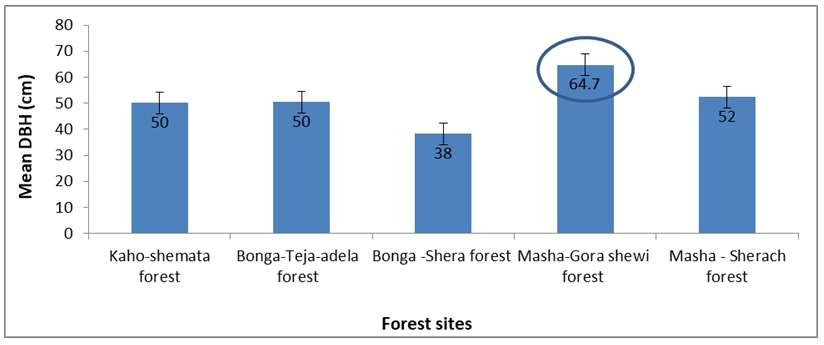
Figure 6 Comparison of mean (x̅)and standard error (SE) for measurements of dbh of Prunus africana population in Kaho-shemeta natural forest, Bonga-Teja-adela forest, Bonga -Shera forest, Masha-Gora shewi forest and Masha - Sherach forest.
Antiaris toxicaria
Population dynamics and regeneration status
The population of Antiaris toxicaria was assessed in Bebeka 1 coffee forest site and Bebeka-kebereta site. Both forest habitats appeared to have the same density of Antiaris toxicaria in hectare. Overall, the ecological descriptions of the pilot forest sites are summarized below (Table 5).
Forest site |
Total counts (N) |
Density (per ha) |
Distribution/ Dispersion |
Reg. status |
Overstory shading |
||
Seedling |
Sapling |
Trees |
(x̅*10000/ 400m2) |
(S2/ x̅ ratio) |
|||
Bebeka 1 |
213 |
0 |
5 |
12.5 |
1=> random distribution |
Fair |
Partial |
Bebeka -Kebereta forest |
10 |
4 |
5 |
12.5 |
1=> random distribution |
Fair |
Partial |
Table 5 Summary descriptions of Bebeka 1 coffee forest and Bebeka-kebereta pilot survey sites in reference to A. toxicaria
Analysis of stem height and dbh
Analysis of t-test for mean stem height of A. toxicaria shows that Bebeka 1 forest (x̅=21.4, SD=5.2, SE=2.3) have statistically not different population at p<0.05 compared to Bebeka-kebereta forest (x̅=22.4, SD=2.7, SE=1.2) (Figure 7). The maximum height recorded in Bebeka 1 forest is 27m and the minimum is 17m. On the other hand, stem height ranges from 18-25m in Bebeka-kebereta forest. So, both or either of the two forests could be used for domestication work and SPA establishment project. Generally, according to Agroforestry Database, A. toxicaria is reported to have 20-40 m stem height.16

Figure 7 Comparison of mean (x̅)and standard error (SE) for measurements of stem height of A. toxicaria population in Bebeka 1 coffee forest and Bebeka-kebereta pilot survey sites.
Analysis of t-test for mean dbh of A. toxicaria populations in shows that the mean variation of DBH between A. toxicaria populations in Bebeka 1 forest (x̅=48, SD=16.4, SE=7.3) and Bebeka-kebereta forest (x̅=48, SD=8.2, SE=3.6) is statistically not significant at p<0.05 (Figure 8). The dbh ranges from 30-60cm in Bebeka 1 coffee forest and from 35-55cm in Bebeka-kebereta forest. On the other hand,16 reported that A. toxicaria normally has a diameter ranging from 0.6 to 1.8m.
In this study, natural forest ecosystems in south and south-western Ethiopia were assessed to find out the population dynamics and dendrological parameters such s stem height and dbh for four important indigenous timber trees. As far as M. excelsa is concerned, Bebeka -Duduka natural forest and Yayu coffee mixed forest appeared to have relatively denser population compared to the other pilot forests; Masha-Gora shewi forest appeared to have dense population of P. adolfi-fridercii and Bebeka-Kebereta as compared to the remaining pilot forests; Masha-Gora shewi and Kaho-shemeta forests appeared to have dense population of Prunus africana as compared to the remaining pilot forests; Antiaris toxicaria have equal density in Bebeka 1 coffee forest site and Bebeka-kebereta sites.
Generally, Bebeka area forest complex is identified as potential in-situ site for domestication and SPA establishment project of Milicia excelsa, Pouteria adolfi-fridercii and Antiaris toxicaria. On the other hand, Kaho-shemeta natural forest and Bonga-Teja-adela forest are identified as potential in-situ site for domestication and SPA establishment project of Prunus africana. Therefore, while implementing the project of domestication and SPA establishment in south and south-western Ethiopia, in-situ and ex-situ areas must be selected and delineated in accordance with this preliminary information of the population dynamics and genetic qualities of stem height and dbh. The survey data generated in this study would bridge the research gap in relation to the population status of the target tree species in the designated area. So, potential users of these findings include biodiversity conservation institutes, forest and environmental institutes, forest and seed enterprise, and other forest-based enterprises such as honey producers, forest extension organizations and others.
UNDP-EFCCC is well acknowledged for financially supporting this project work. We are also grateful to the local communities and government sector offices in the study areas for making this work possible.
None.
The authors declare there are no conflicts of interest.

©2020 Seid, et al. This is an open access article distributed under the terms of the, which permits unrestricted use, distribution, and build upon your work non-commercially.